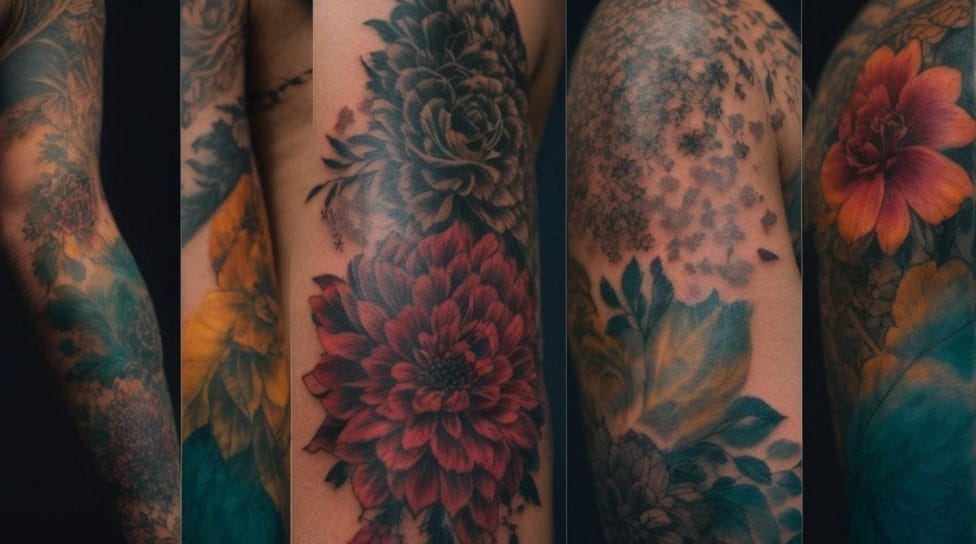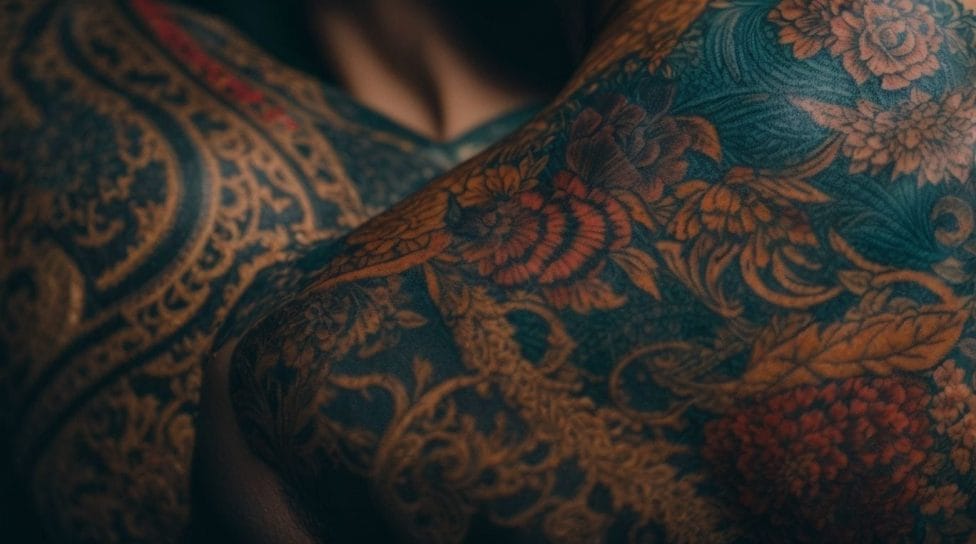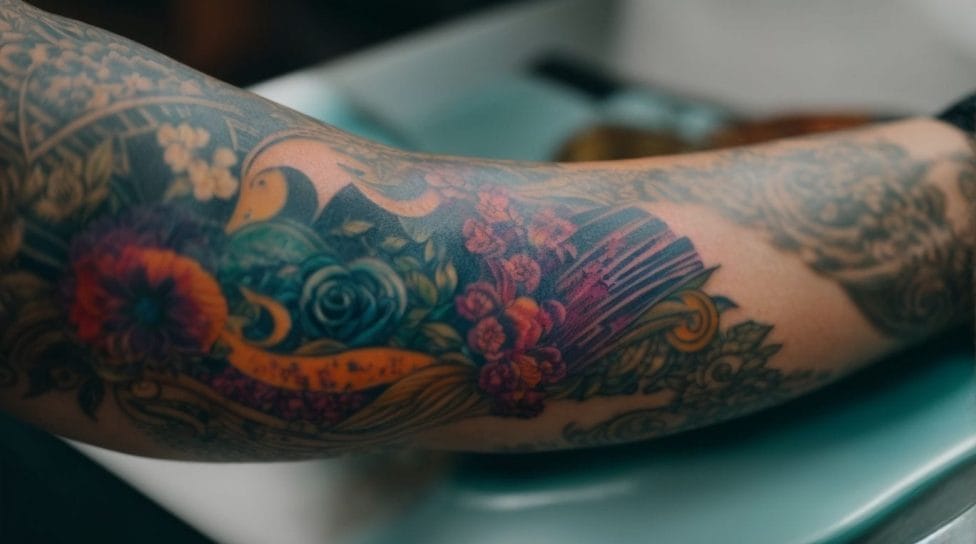Tattoos are a form of body art that requires careful aftercare to ensure proper healing. The healing process of a tattoo can vary from person to person and is influenced by several factors. Understanding the stages of tattoo healing, the factors affecting healing time, and how to promote healing is essential for anyone getting a tattoo.
The stages of tattoo healing typically include immediate aftercare, scabbing and peeling, itching and dryness, and complete healing. During the immediate aftercare stage, it is crucial to follow the tattoo artist’s instructions to prevent infection and promote healing. The tattoo will then go through scabbing and peeling, which is a normal part of the healing process. Following this, itching and dryness may occur as the skin regenerates. Finally, the tattoo will reach the stage of complete healing, where the skin is fully regenerated, and the tattoo looks its best.
Several factors can affect the healing time of a tattoo. The size and complexity of the tattoo can play a role, as larger and more intricate tattoos may take longer to heal. The placement of the tattoo on the body can also impact healing time, with areas that experience more movement or friction taking longer to heal. Individual healing abilities vary, and some people may heal faster or slower than others. Proper aftercare practices, such as keeping the tattoo clean and moisturized, can also influence healing time.
The expected healing time for different tattoo sizes can vary. Small tattoos may take around one to two weeks to fully heal, while medium tattoos may require two to four weeks. Large tattoos, especially those that cover a significant portion of the body, may take four to six weeks or longer to heal completely.
To promote tattoo healing, it is important to follow a proper aftercare routine. This includes keeping the tattoo clean and moisturized with specific ointments recommended by the tattoo artist. It is also necessary to avoid irritants and excessive sun exposure, as these can hinder the healing process and potentially cause complications.
While most tattoos heal without any issues, it is essential to be aware of signs of healing complications. These can include excessive redness, swelling, prolonged pain, pus, or an unpleasant odor. If any of these signs occur or if you have concerns about the healing process, it is advisable to seek medical attention to ensure proper care and prevent infection.
Understanding the healing stages, factors affecting healing time, and how to promote healing can help individuals with tattoos have a successful and smooth healing process. By following proper aftercare practices and paying attention to any signs of complications, you can ensure your tattoo heals beautifully and lasts for years to come.
Key takeaways:
- Tattoo healing involves various stages: Immediate aftercare, scabbing and peeling, itching and dryness, and complete healing.
- Tattoo healing time depends on factors such as size, complexity, placement, individual healing abilities, and aftercare practices.
- To promote tattoo healing, follow a proper aftercare routine, keep the tattoo clean and moisturized, and avoid irritants and sun exposure.
Stages of Tattoo Healing

Photo Credits: Tattooineplanet.Com by Vincent Gonzalez
As our tattoos become a part of us, it’s crucial to understand the stages of tattoo healing. From immediate aftercare to complete healing, we’ll embark on a journey of understanding the different phases our tattoos go through. We’ll witness the delicate process of scabbing and peeling, the inevitable itching and dryness, and finally, the grand finale of complete healing. So grab your curiosity and let’s dive into the fascinating world of tattoo healing!
1. Immediate Aftercare
To ensure a healthy healing process for your tattoo, it is crucial to provide immediate aftercare. Follow these steps for proper tattoo healing:
- Cleanse: Begin by gently washing the tattoo with lukewarm water and mild antibacterial soap. This will effectively remove any blood, ointment, or plasma that may be present.
- Dry: Use a clean, soft towel to pat the tattoo dry. It is important to avoid rubbing or using a rough cloth as it can cause irritation or damage.
- Ointment Application: Apply a thin layer of the recommended tattoo ointment or lotion to keep the tattoo moisturized and protected.
- Avoid Exposure: Protect the tattoo from dirt and bacteria by covering it with a clean and breathable dressing for the first few hours.
- Avoid Touching: Prevent infections by refraining from touching the tattoo with dirty hands.
- Clothing Choice: Opt for loose and comfortable clothing to avoid friction and irritation on the healing tattoo.
- Avoid Swimming: To prevent bacteria contamination, it is best to stay away from pools, hot tubs, and saunas.
2. Scabbing and Peeling
During the tattoo healing process, the stage of scabbing and peeling, also known as Scabbing and Peeling, is a crucial phase. Here are the steps involved in this stage:
- Scabbing: The tattooed area forms a protective layer of scabs as part of the natural healing process. Avoid picking or scratching the scabs to prevent scarring.
- Peeling: After the scabs have formed, they will start to peel off, revealing the new layer of healed skin underneath. It is important to let the peeling occur naturally, without forcefully removing the flakes.
- Moisturize: Apply a thin layer of tattoo aftercare ointment or unscented lotion to keep the tattooed area moisturized. This helps in the healing process and prevents excessive dryness.
- Avoid sun exposure: Protect your tattoo from direct sunlight, as it can cause fading and damage to the healing skin.
Remember to follow these steps carefully during the scabbing and peeling stage to ensure proper healing and maintain the quality of your tattoo.
3. Itching and Dryness
During the tattoo healing process, itching and dryness are common occurrences that typically arise around the second or third week after receiving a tattoo. The body naturally responds with an itch as the skin heals and new skin cells develop. Additionally, dryness may arise as the skin repairs itself. To effectively promote proper healing and alleviate these sensations, it is crucial to refrain from scratching the tattoo. Instead, it is recommended to apply a fragrance-free moisturizer, as suggested by your tattoo artist. By keeping the tattoo moisturized and avoiding irritants, complications can be prevented, resulting in a beautiful outcome.
4. Complete Healing
Complete healing of a tattoo is a vital stage in the tattoo healing process. During this phase, the skin fully regenerates, and the tattoo becomes stable and vibrant. Achieving complete healing requires proper care and adherence to aftercare instructions. Here are the essential steps for achieving complete healing:
- Keep the tattoo clean by gently washing it with mild soap and water.
- Apply a thin layer of fragrance-free and hypoallergenic moisturizer to keep the skin hydrated.
- Avoid picking or scratching the tattoo to prevent scarring and infection.
- Avoid exposure to direct sunlight and always apply sunscreen to protect the tattoo from fading.
- Continue following the aftercare routine until the tattoo is fully healed.
By following these steps, you can ensure that your tattoo heals properly and maintains its beauty for years to come.
Factors Affecting Tattoo Healing Time

Photo Credits: Tattooineplanet.Com by Russell Green
When it comes to tattoo healing time, there are several factors that can make a difference. From the size and complexity of the tattoo design to its placement on the body, each aspect plays a role. Individual healing abilities and aftercare practices can also impact how quickly a tattoo heals. So, if you’re wondering how long your tattoo will take to heal, let’s dive into these factors and uncover what you need to know.
1. Tattoo Size and Complexity
The healing process of a tattoo can be significantly affected by its size and complexity.
| Tattoo Size | Healing Time |
| Small Tattoos | 1-2 weeks |
| Medium Tattoos | 2-4 weeks |
| Large Tattoos | 4-6 weeks or longer |
Larger and more complex tattoos require more time to heal due to their larger size and more intricate designs. It is essential to properly care for the tattoo after getting it done to ensure timely healing. This includes keeping the tattoo clean and moisturized, as well as avoiding irritants and sun exposure. If any complications arise, such as excessive pain or infection, it is recommended to promptly seek medical attention.
2. Tattoo Placement
When it comes to tattoo healing, the tattoo placement plays a crucial role in the process. Here are the steps to consider:
- Choose the right tattoo placement: Consider factors like visibility, pain tolerance, and potential stretch or distortion of the tattoo over time.
- Consult with the tattoo artist: They can provide guidance on the best tattoo placement options based on the design and your body type.
- Take care of the tattoo during healing: Follow proper aftercare instructions specific to the tattoo placement, such as avoiding tight clothing or excessive movement.
Remember, each person’s healing process may vary, so it’s important to listen to your body and consult with a professional if you have any concerns.
3. Individual Healing Abilities
Individual healing abilities play a crucial role in the healing process of a tattoo. The speed and effectiveness of healing can vary from person to person, depending on factors such as genetics, overall health, and immune system function. The healing process may be faster and less complicated for some individuals, while others may experience a slower healing process or be more susceptible to complications like infection or scarring. It is essential to understand and acknowledge your own healing abilities and to follow proper aftercare practices to ensure optimal healing.
In ancient times, people often attributed individual healing abilities to supernatural or divine intervention. It was believed that those with strong healing abilities possessed special powers or had connections to higher beings. These individuals were highly esteemed in their communities and were sought after for their exceptional healing skills. As time passed and medical knowledge advanced, it became apparent that individual healing abilities are influenced by a combination of genetic factors, lifestyle choices, and overall health. Today, we still acknowledge and respect the distinct healing abilities of each individual.
4. Aftercare Practices
Proper aftercare practices, such as keeping the tattoo clean, applying ointment or moisturizer, avoiding scratching or picking, and protecting the tattoo from sun and water, are crucial for the healing process of a tattoo. It is also important to wear loose clothing to prevent rubbing and irritation. By following these aftercare practices, you can ensure a smooth healing process and maintain the quality of your tattoo.
Expected Healing Time for Different Tattoo Sizes

Photo Credits: Tattooineplanet.Com by Robert Green
When it comes to getting a tattoo, one of the burning questions on everyone’s mind is: how long will it take to heal? Well, in this section, we’re going to dive into the expected healing times for tattoos of different sizes. From small tattoos to medium and large ones, we’ll cover it all. So if you’re curious about how much time you’ll need to give your tattoo to fully heal and settle, stick around because we’ve got you covered!
1. Small Tattoos
- Small tattoos are a popular choice due to their simplicity and versatility. Here are a few key considerations when getting a
small tattoo
- :
Design: Opt for a simple and minimalistic design that will stand the test of time.
Placement: Small tattoos can be placed almost anywhere on the body, allowing for creativity and personal expression.
Pain: Smaller tattoos tend to be less painful compared to larger ones, making them perfect for first-timers.
Healing time: Small tattoos generally heal faster, usually within 1-2 weeks, compared to larger pieces.
Care: Proper aftercare is crucial for small tattoos to avoid infections and ensure proper healing.
Small tattoos have a rich history, dating back thousands of years. In ancient times, small tattoos were used to symbolize protection, strength, and spirituality. Today, small tattoos continue to be a popular choice, representing individuality and personal significance.
2. Medium Tattoos
Medium tattoos, typically ranging from a few inches to around a forearm size, have their own healing process. Ensure proper healing by following these guidelines:
- Keep it clean: Gently wash the medium tattoo with a mild, fragrance-free soap and water.
- Moisturize regularly: Apply a thin layer of fragrance-free lotion to keep the medium tattoo hydrated.
- Avoid picking or scratching: Itching is common during this stage, but refrain from scratching or picking at the scabs of your medium tattoo.
- Protect from sunlight: Shield the medium tattoo from direct sunlight and apply sunscreen if necessary.
- Wear loose clothing: Opt for loose-fitting clothes to prevent rubbing and irritation of your medium tattoo.
Medium tattoos have been a popular choice for centuries. From ancient civilizations to modern times, medium-sized designs allow for intricate details and meaningful artistry. Whether it’s a memorial tribute or an expression of personal creativity, medium tattoos continue to be a prominent form of self-expression.
3. Large Tattoos
Large tattoos necessitate additional care and attention while they are in the process of healing. Take into account the following significant factors:
- Increased size: Large tattoos encompass a more extensive area of skin, which makes them more susceptible to swelling and discomfort.
- Extended healing time: Due to the comprehensive work involved, larger tattoos typically require a longer duration to fully heal compared to smaller ones.
- Proper aftercare: It is essential to adhere strictly to an aftercare regimen for large tattoos, which includes cleansing, moisturizing, and avoiding exposure to irritants.
- Possible touch-ups: Depending on the complexity and color intensity, large tattoos may need additional sessions to ensure optimal outcomes.
- Story: Recently, one of my friends acquired a sizable tattoo on her back that took several months to completely heal. She diligently followed the aftercare instructions, underwent touch-up sessions when necessary, and now proudly exhibits her stunning, fully healed tattoo.
Promoting Tattoo Healing

Photo Credits: Tattooineplanet.Com by Alexander Rodriguez
Promoting Tattoo Healing is all about giving your ink the TLC it needs for a speedy recovery. From establishing a proper aftercare routine to safeguarding your masterpiece against irritants and sun exposure, we’ve got you covered. Discover the secrets to maintaining a clean and moisturized tattoo, ensuring it heals beautifully. Let’s dive into the wonderful world of tattoo healing and unlock the key to preserving your body art for a lifetime.
1. Proper Aftercare Routine
“`
A proper aftercare routine is crucial for tattoo healing. Following a proper aftercare routine is essential in achieving a well-healed tattoo. Follow these steps carefully to ensure proper healing and minimize the risk of infection:
- Keep the bandage on for at least a few hours to protect the tattoo from bacteria.
- Gently wash the tattoo with lukewarm water and mild soap, using clean hands.
- Remember to maintain a proper aftercare routine.
- Tenderly pat the tattoo dry with a clean towel and avoid rubbing.
- Apply a thin layer of fragrance-free moisturizer to keep the tattoo hydrated.
- It’s important to refrain from exposing the tattoo to direct sunlight, swimming pools, saunas, or hot water for a few weeks.
- Avoid picking or scratching the tattoo, as it can cause scarring and prolong the healing time.
Always remember, proper aftercare routine is crucial for achieving optimal tattoo healing results.
2. Keeping the Tattoo Clean and Moisturized
- It is crucial to keep the tattoo clean and moisturized for proper healing and preventing infection. To achieve this, follow these essential steps:
- Before touching your tattoo, make sure to wash your hands thoroughly.
- Use a mild, fragrance-free soap and lukewarm water to gently clean the tattooed area.
- Dry the tattoo by patting it with a clean paper towel or allowing it to air dry.
- Apply a thin layer of a fragrance-free, non-alcoholic tattoo ointment or moisturizer as recommended by your tattoo artist.
- To prevent irritation or scarring, avoid picking, scratching, or rubbing the tattoo.
- Follow the instructions of your tattoo artist and moisturize the tattoo 2-3 times a day.
- During the healing process, refrain from exposing the tattoo to direct sunlight, swimming pools, hot tubs, or saunas.
- To promote proper airflow and prevent friction, wear loose and breathable clothing around the tattooed area.
3. Avoiding Irritants and Sun Exposure
It is essential to prioritize the avoidance of irritants and sun exposure in order to promote proper healing of your tattoo. To ensure the best possible outcome, follow the steps outlined below:
- Refrain from scratching, picking, or rubbing your tattoo as these actions can impede the healing process and elevate the risk of infection.
- Shield your tattoo from direct sunlight, as UV rays have the potential to fade the vibrant colors and harm your skin. If the tattoo is exposed to the sun, generously apply a sunscreen with a high SPF to provide adequate protection.
- Avoid submerging your tattoo in pools, hot tubs, or baths, as prolonged water exposure can soften scabs and hinder the healing process.
- Avoid wearing tight clothing that may cause irritation or chafing over your tattoo.
- Refrain from applying harsh chemicals or lotions to your tattoo, as these substances can irritate your skin and disrupt the healing process.
Signs of Tattoo Healing Complications

Photo Credits: Tattooineplanet.Com by Mason Hill
While tattoos generally take a few weeks to heal, it is important to be aware of signs that may indicate complications during the healing process.
- Infection: Look for symptoms such as increased redness, swelling, tenderness, and pus-like discharge.
- Delayed healing: If your tattoo takes significantly longer than usual to heal, it may be a sign of an underlying issue.
- Excessive pain: While some discomfort is normal, severe or worsening pain could indicate an infection or other problem.
- Excessive swelling: Swelling is common initially, but if it persists or worsens, it may be a sign of infection or an allergic reaction.
- Changes in color or texture: If your tattoo becomes increasingly raised or develops unusual discoloration, it is important to seek medical advice.
During the healing process of a tattoo, it is crucial to be mindful of signs of tattoo healing complications.
- One of the signs to watch out for is infection, which can be identified through symptoms like increased redness, swelling, tenderness, and pus-like discharge.
- Another indicator of possible issues is delayed healing, where your tattoo takes longer than usual to heal, implying an underlying problem.
- Experiencing excessive pain is another sign to be vigilant about. While some level of discomfort is expected, severe or worsening pain might indicate an infection or another complication.
- It is common for swelling to occur initially, but if it persists or worsens, it could signify an infection or an allergic reaction.
- Additionally, if your tattoo starts to show changes in color or texture, such as increased raised areas or unusual discoloration, seeking medical advice becomes crucial.
When to Seek Medical Attention

Photo Credits: Tattooineplanet.Com by Aaron Rivera
If you experience any unusual symptoms during the healing process of a tattoo, it is important to know when to seek medical attention. To know when to seek medical attention, look for signs of infection, such as excessive redness, swelling, or discharge, and seek immediate medical assistance if you notice them. Similarly, if you experience severe pain that doesn’t subside or if the tattoo becomes increasingly warm or tender, it’s important to consult a healthcare professional. It’s crucial to seek medical help promptly if you notice any allergic reactions, like itching, rash, or difficulty breathing. Remember, when it comes to your health, it’s always better to be safe than sorry.
A friend of mine noticed persistent redness and swelling around their tattoo. They knew when to seek medical attention and promptly sought medical assistance. The result was a diagnosis of a skin infection and prompt treatment, which saved them from potential complications and ensured proper healing. So, it’s crucial to listen to your body and know when to seek medical assistance.
Some Facts About How Long Tattoos Take to Heal:
- ✅ The outer layer of a tattoo typically heals within 2-3 weeks, but the entire healing process can take up to 6 months. (Source: numbedink.com)
- ✅ The first 24-48 hours after getting a tattoo are crucial for the healing process. (Source: numbedink.com)
- ✅ During the initial healing period, there may be burning sensation, redness, and oozing. (Source: numbedink.com)
- ✅ Cleaning the tattoo at least 3 times a day with warm water and unscented soap is important for proper healing. (Source: numbedink.com)
- ✅ Moisturizing the tattooed area with non-scented lotion twice a day helps keep the skin hydrated and promotes better healing. (Source: numbedink.com)


